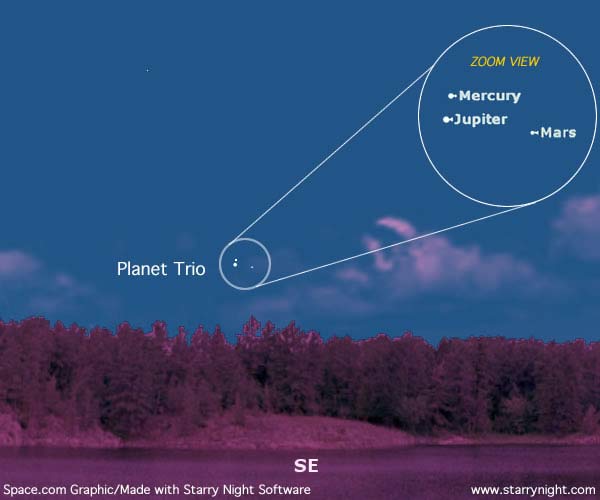
Jupiter, Mercury and Mars are destined in the coming days to crowd into a small spot in the sky, making for a most intriguing gathering very low in the east-southeast sky.
A wide variety of different conjunctions and configurations involving the planets typically occur during the course of any given year. It is rather unusual, however, when three or more bright planets appear to reside in the same small area of the sky.
From our Earthly vantagepoint, we can readily observe Mercury, Venus, Mars, Jupiter and Saturn with our unaided eyes as they revolve around the Sun. Each of these planets appears to move against the starry background at their own speeds and along their own tracks. It is obvious that since they are constantly moving at different speed, the positions of all five planets at any particular time is unique to that particular moment.
Jean Meeus of Belgium, recognized as a world authority in spherical and mathematical astronomy, has defined the term "planetary trio" as when three planets fit within a circle with a minimum diameter smaller than 5 degrees. Your clinched fist held at arm's length, for instance, is equal to roughly 10 degrees; the pointer stars at the end of the bowl of the Big Dipper are separated by just over five degrees).
"That limit of 5 degrees has been chosen more or less arbitrarily," notes Meeus, "but we have to make a choice."
Between Dec. 7 and 14, the planets Jupiter (magnitude -1.7), Mercury (-0.6) and Mars (+1.5) will fit within a 5-degree circle [Sky Map].
The best time to look for them will be around 6:30 a.m. local standard time. At that hour, they will be hovering very low over the east-southeast horizon in the brightening dawn twilight. Unfortunately, their low altitude, plus this gathering's proximity to the Sun will probably render Mars invisible (or nearly so) to the unaided eye. So I would strongly recommend that you use binoculars if you have any hopes of seeing it. In contrast, Mercury and Jupiter should be readily visible to the eye with only slight difficulty, as they respectively will appear about 3 and 19 times brighter than Mars.
Get the Space.com Newsletter
Breaking space news, the latest updates on rocket launches, skywatching events and more!
Each morning you'll be able to watch how these three worlds change their positions relative to each other.
The trio will be most compact-fitting within a 1-degree circle-on Dec. 10. On this morning, before sunrise, the three planets will resemble a compact arrowhead pointing west, with Mars at the arrowpoint. Through this 7-day interval there will also be separate conjunctions between Mercury and Mars (1.0-degree apart on Dec. 9), Mercury and Jupiter (only 0.1-degree apart on December 10th) and Mars and Jupiter (0.8-degree apart on Dec. 11).
Also, for binocular viewers on the morning of Dec. 10, Mercury will lie just 0.15-degree below and to the right of the +2.5 magnitude star Graffias in Scorpius, the Scorpion. In some older star books, Graffias is sometimes labeled as Akrab. It is generally regarded as one of finest double stars in the sky for small telescopes.
I'll end this week's column with an answer to a question I suspect many might be asking at this point. Are planet trios rare events? The answer, which may be surprising to some, is, not really. In his research, Dr. Meeus compiled a listing of all the trios that occur during the interval from 1980 through 2050. He found 40, which translates to a frequency of one every 21 months on average. In fact, the last planet trio took place just 18 months ago and involved Mercury, Venus and Saturn. However, some of these trios are all but impossible to observe. A good example is one that occurred in September 2004 with Mercury, Mars and Jupiter. That trio convened only 5-degrees from the Sun and of course was invisible.
What does make this trio special is that it is the most compact one in Dr. Meeus' list. Over that 70-year time span, there is no other case where three naked-eye planets converge to with less than one-degree of each other. The only planet trio that fits this criterion is the upcoming one on Dec. 10.
Basic Sky Guides
- Full Moon Fever
- Astrophotography 101
- Sky Calendar & Moon Phases
- 10 Steps to Rewarding Stargazing
- Understanding the Ecliptic and the Zodiac
- False Dawn: All about the Zodiacal Light
- Reading Weather in the Sun, Moon and Stars
- How and Why the Night Sky Changes with the Seasons
- Night Sky Main Page: More Skywatching News & Features
Joe Rao serves as an instructor and guest lecturer at New York's Hayden Planetarium. He writes about astronomy for The New York Times and other publications, and he is also an on-camera meteorologist for News 12 Westchester, New York.
Join our Space Forums to keep talking space on the latest missions, night sky and more! And if you have a news tip, correction or comment, let us know at: community@space.com.

Joe Rao is Space.com's skywatching columnist, as well as a veteran meteorologist and eclipse chaser who also serves as an instructor and guest lecturer at New York's Hayden Planetarium. He writes about astronomy for Natural History magazine, Sky & Telescope and other publications. Joe is an 8-time Emmy-nominated meteorologist who served the Putnam Valley region of New York for over 21 years. You can find him on Twitter and YouTube tracking lunar and solar eclipses, meteor showers and more. To find out Joe's latest project, visit him on Twitter.









